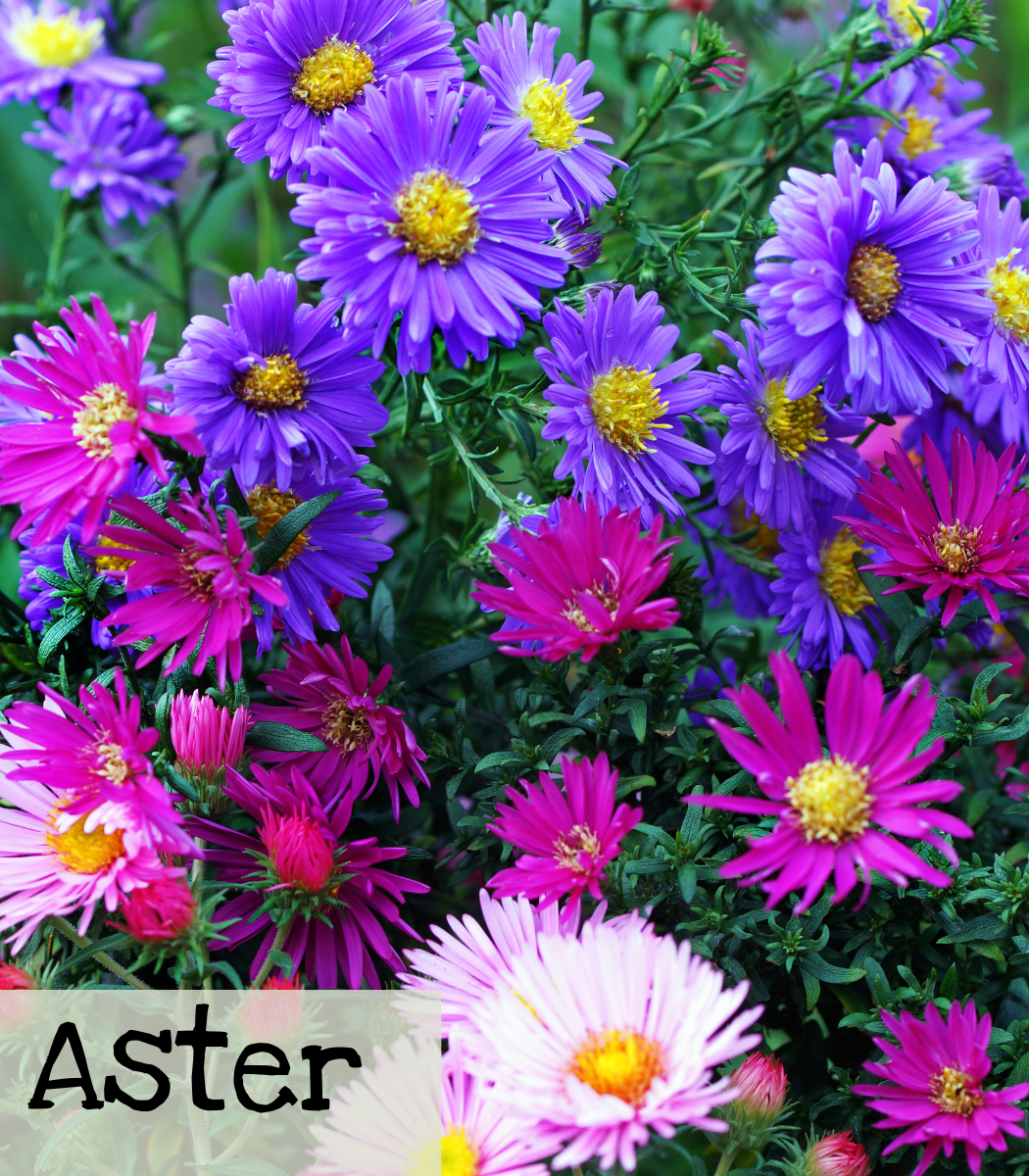
Aster
The Chinese aster, Callistephus chinensis, is a member of the sunflower family. These late-blooming flowers are a good fall nectar source for bees and many other insects when other flowers start to die back.
|
Giant Perfection Mix |
|
Callistephus chinensis |
|
Intermediate |
|
Intermediate |
|
1-2 years if properly stored |
|
Annual |
|
10-14 days |
|
Helpful to cold-stratify for 2 weeks if using saved seeds. |
|
1/8 inch |
|
24” |
|
Full sun |
|
80-100 days |
|
March, April and May |
|
No |

Growing Tips


4 plants per 20” container
When to Start
Spring: Start indoors 6-8 weeks before transplanting. Direct sow/transplant after the danger of frost has passed.
How to Start
Start seedlings 6-8 weeks before transplanting or direct sow after the danger of frost has passed. Sow to a depth of 1/8 inch. Keep seeds/seedlings moist but not soggy. According to Rareseeds.com, if you are starting seeds you saved, it is helpful to cold stratify them for 2 weeks before starting the seedlings indoors or direct sowing.
Care
Asters prefer well-draining soil and full sun. However, they can tolerate part shade. The tricky thing with growing asters is to NOT let the soil dry out. Asters dislike dry soil at any stage of their life (from seed to plant). Mulching can help keep the plants moist and has the added benefit of keeping weeds down. Asters don’t like to be crowded. Avoid overcrowding by thinning them to 12 inches apart. They will benefit further from this spacing, as this will allow more airflow between plants.
Taller varieties will require staking. To have continuous blooms stagger planting times as asters will not rebloom after deadheading.
Special Note:
Callistephus chinensis is NOT a true aster and is NOT a host plant for the Pearl Crescent butterfly. The host plant for the Pearl Crescent butterfly is the New England Aster, Symphyotrichum novae-angliae. However, the Callistephus chinensis aster is an excellent nectar plant for many butterflies and is an attractive addition to any garden. Due to its late blooms, it is a perfect food source for migrating butterflies in the Fall.
My personal Experience
I’ve never had luck growing aster in GA. I know it can be done because the UGA botanical gardens has an impressive display of asters. I’ve tried a few times and I think the reason they haven’t done well is due to not keeping them as moist as they like. I’m determined to figure it out as the New England Aster is a host plant for the Pearl Crescent butterfly. I would like to include this butterfly in the JPL butterfly garden by having host plants for its life cycle.
Seed Saving

Isolation Distance
Insect dependent for pollination. Isolate 1/2 mile to prevent cross-pollination.
Instructions
Select healthy, robust plants free of any signs of disease or insect infestation for seeds. Seeds carry the traits of the parent plant. Choose plants that exhibit the traits you wish to preserve. Consider bloom size, color and shape, as well as blooming time.
Allow the biggest and healthiest blooms to mature on the plant. Cover the seed head with a fine-mesh bag as soon as flower petals shrivel and die. Wait to remove from the plant until the once-golden center turns brown and the seed head has formed. Use an elastic band to hold the bag in place. This prevents seeds from spilling onto the soil before harvest. When the seed head forms fluffy tufts of cotton-looking material you can clip the flower head from the plant.
Flower heads that have gone to seed may look dry, but still, be moist on the inside. Dry seeds in a cool, dry location with good air circulation for one week before removing seeds and debris. Separate plant debris from the seeds by removing the mesh bag. Place a piece of paper or tray under the seed heads. Gently rub the dry heads until they loosen and fall in removing as much debris as possible. Gently blow across the paper to remove the remaining fluff. Store in a paper bag.
Features
- Blooms late Summer to Fall
- Good cut flowers
- Nectar plant for migrating butterflies
- Attracts pollinators
- Container friendly

Plant in different locations each year to reduce the risk of spreading potential pests or diseases.
Aster will not re-bloom after deadheading. Use succession planting for continuous blooms.
Sources:
Edenbrothers.com
Gardenerspath.com
Flowering Annuals for Georgia Gardens by Cooperative Extension Service/The University of Georgia College of Agriculture/Athens
